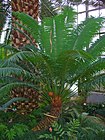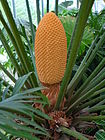Note: This is a project under development. The articles on this wiki are just being initiated and broadly incomplete. You can Help creating new pages.
Difference between revisions of "Cycas circinalis - Hintala"
(Created page with "thumb|right|''Hintala'', ''Cycas circinalis'' '''Hintala'''belongs to an ancient group of plants, the cycads. It is a gr...") |
(→External Links) |
||
| Line 94: | Line 94: | ||
[[Category:Herbs]] | [[Category:Herbs]] | ||
[[Category:Plants of western ghats]] | [[Category:Plants of western ghats]] | ||
| + | [[Category:Ayurvedic herbs that don't have seed photos] | ||
Revision as of 14:31, 15 May 2019
Hintalabelongs to an ancient group of plants, the cycads. It is a graceful palm like plant with tough pinnate leaves and rough bark. Cycas circinalis is uncommon in India and can be found in dry as well as well as wet forests in peninsular India.
Contents
- 1 Uses
- 2 Parts Used
- 3 Chemical Composition
- 4 Common names
- 5 Properties
- 6 Habit
- 7 Identification
- 8 List of Ayurvedic medicine in which the herb is used
- 9 Where to get the saplings
- 10 Mode of Propagation
- 11 How to plant/cultivate
- 12 Commonly seen growing in areas
- 13 Photo Gallery
- 14 References
- 15 External Links
Uses
Arthritis, Burning sensation, vomiting, fever, Hemorrhoids [1]
Parts Used
Chemical Composition
Common names
| Language | Common name |
|---|---|
| Kannada | goddeechalu, mundichalu |
| Hindi | jangli-madan-must-ka-phul |
| Malayalam | eenthakay, entha, ichal, indalapana, toddapana |
| Tamil | intapanai, kama, kama-maram, madana-kamampu |
| Telugu | dzavvubiyyamu, kamakshi, madana kamakshi, madana mastu, varugudu |
| Marathi | NA |
| Gujarathi | NA |
| Punjabi | NA |
| Kashmiri | NA |
| Sanskrit | hintalah |
| English | Sago palm, cycad |
Properties
Reference: Dravya - Substance, Rasa - Taste, Guna - Qualities, Veerya - Potency, Vipaka - Post-digesion effect, Karma - Pharmacological activity, Prabhava - Therepeutics.
Dravya
Rasa
Madhura (Sweet). Kashaya (Astringent)
Guna
Guru (Heavy), Snigdha (Oily)
Veerya
Sheeta (cold)
Vipaka
Karma
Pitta, Vata
Prabhava
Habit
Identification
Leaf
| Kind | Shape | Feature |
|---|---|---|
| pinnate | Crowded at top of stem | The leaves are bright green, semiglossy, 150-250 cm long, flat (not keeled) in
section (opposing leaflets inserted at 180° on rachis), with 170 leaflets, tomentum shedding as leaf expands |
Flower
| Type | Size | Color and composition | Stamen | More information |
|---|---|---|---|---|
| Unisexual | Male and female on separate individuals | Yellow-brown | Male Sago plants develop a cone approximately 30 cm tall coming from the center of the top. The cone is white or yellow, rounded and produces abundant pollen. The female inflorescence is displayed on the feather-like seed-bearing leaves. Microsporophylls densely aggregated to form large terminal cones. Megasporophylls loosely arranged, crowded round the apex of stem; ovules 1-5 on either side of sporophyll. Seeds globose. |
Fruit
| Type | Size | Mass | Appearance | Seeds | More information |
|---|---|---|---|---|---|
| Globose | The seeds have a spongy layer that allows them to float on water. As a slow growing plant, the seed can take from 6–18 months to germinate | {{{6}}} |
Other features
List of Ayurvedic medicine in which the herb is used
Where to get the saplings
Mode of Propagation
How to plant/cultivate
Season to grow
Soil type
Propagation
Commonly seen growing in areas
Photo Gallery
References
External Links
- http://tropical.theferns.info/viewtropical.php?id=Cycas+circinalis
- http://www.naturalmedicinalherbs.net/herbs/c/cycas-circinalis=sago-palm.php
[[Category:Ayurvedic herbs that don't have seed photos]
- Ayurvedic Herbs known to be helpful to treat Arthritis
- Ayurvedic Herbs known to be helpful to treat Burning sensation
- Ayurvedic Herbs known to be helpful to treat vomiting
- Ayurvedic Herbs known to be helpful to treat fever
- Ayurvedic Herbs known to be helpful to treat Hemorrhoids
- Herbs with Bark used in medicine
- Herbs with Leaves used in medicine
- Herbs with Seeds used in medicine
- Herbs with common name in Kannada
- Herbs with common name in Hindi
- Herbs with common name in Malayalam
- Herbs with common name in Tamil
- Herbs with common name in Telugu
- Herbs with common name in Sanskrit
- Herbs with common name in English
- Habit - Palm-like
- Index of Plants which can be propagated by Seeds
- Herbs that are commonly seen in the region of Tropical area
- Herbs
- Plants of western ghats




